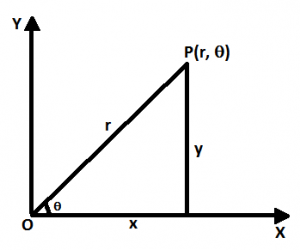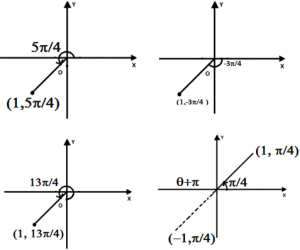Polar Coordinates
Polar Coordinates express the location of a point as (r, θ). Where r is the distance from the origin (pole) to the point and θ is the angle from the positive x – axis to the point (in degree or radius). Here, r and θ are called polar coordinates. The distance r is also the hypotenuse of the right triangle formed using the x – axis. Using the Pythagorean theorem and trigonometric functions.

r = √(x² + y²) and θ = tan¯¹(y/x)
we extend the meaning of polar coordinates (r, θ) to the case in which r is negative by agreeing that the points (-r, θ) and (r, θ) lie in the same line through O and at the same distance |r| from O, but on the opposite sides of O, if r>0, the point (r, θ) lies in the same quadrant as θ, if r < 0, it lies in the quadrant on the opposite side if the pole.

Thus, (-r, θ) is the same as (r, θ + π).
In the cartesian coordinate system, every point has only one representation, but in the coordinate system, each point has many representations, for instance, the point (1, 5π/4) can be written as (1, -3π/4) or (1, 13π/4) or (-1, π/4).

